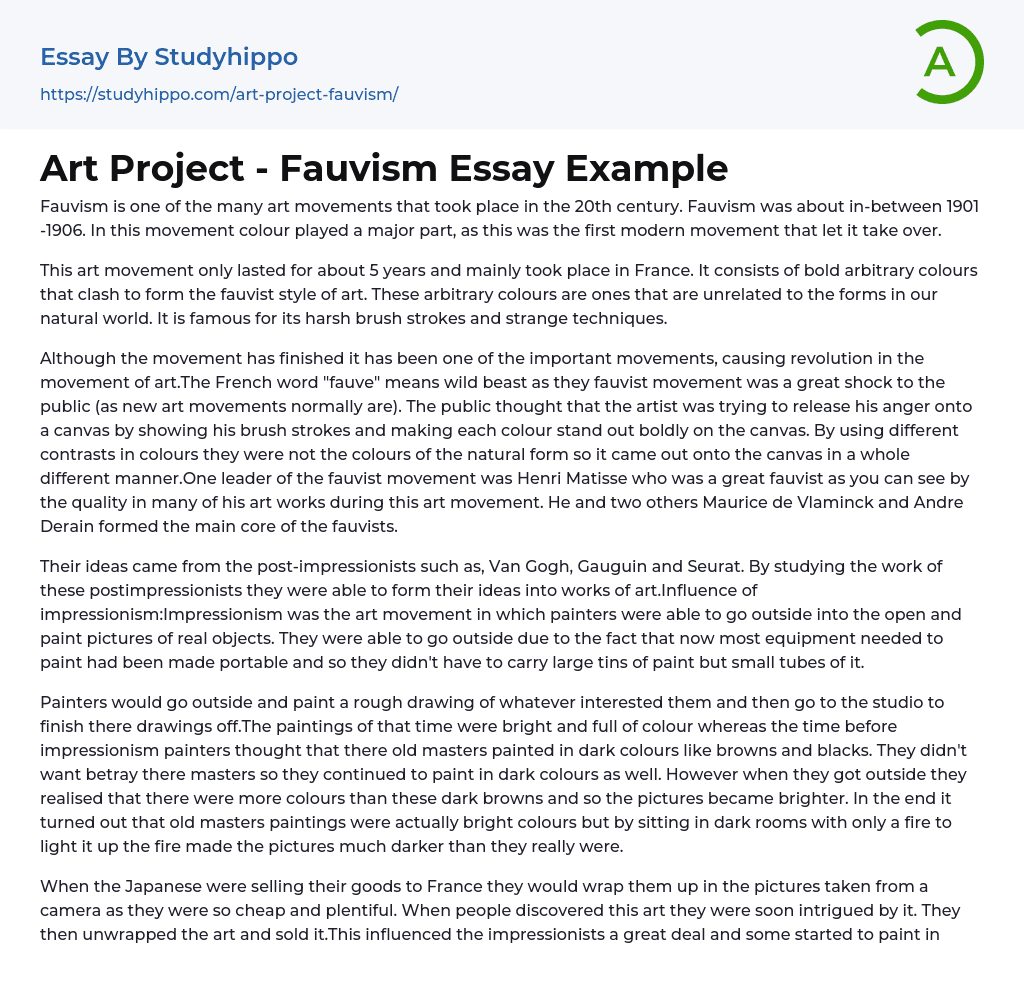Fauvism, which occurred in the early 1900s, is among the numerous art movements from the 20th century. The focus of Fauvism was on color, and it was the first modern movement to highlight this aspect extensively.
The fauvist style of art emerged in France and lasted for a brief period of 5 years. This movement is characterized by the use of bold arbitrary colors that clash with each other. These colors are unrelated to the natural forms found in our world. The harsh brush strokes and unconventional techniques used in this style have made it famous.
Despite its conclusion, the fauvist movement remains significant for its revolutionary impact on the art world. The term "fauve," translating to "wild beast" in French, caused quite a shock to the public, as often happens with the emergence of new art movements. Viewers believed that the
...artist was venting their anger on the canvas by emphasizing bold brush strokes and contrasting colors that didn't necessarily reflect natural forms. This approach resulted in a distinct visual style. Henri Matisse was a prominent figure in the fauvist movement, showcasing his talent in many works. Along with Maurice de Vlaminck and Andre Derain, Matisse formed a core group of fauvists.
Their ideas were influenced by post-impressionists such as Van Gogh, Gauguin, and Seurat. Through studying the works of these artists, they were able to create their own art. Impressionism played a role in this process by enabling painters to work outdoors and capture real objects in their paintings. The development of portable painting equipment allowed them to carry small tubes of paint instead of large tins.
Painters used to create preliminary sketches outdoor
and complete their work in the studio. Prior to the impressionist movement, artists believed the old masters painted with dull colors such as brown and black. They continued to use these colors so as not to betray their predecessors. However, when they ventured outside, they discovered a wider spectrum of colors and their paintings became brighter. It was eventually realized that the old masters' works were actually painted with bright colors that appeared darker due to the lighting of the time - dimly lit rooms with only fire as a source of light.
Using cheap and abundant photographs as wrapping for Japanese products was a captivating trend in France. This led to the unwrapping of these images, which were subsequently sold as art, and had a significant impact on impressionism. Pointillism techniques began being used by some impressionists, while the attention-grabbing usage of complementary colors caught the eye of Fauvists. Van Gogh's influence has also extended beyond Fauvism to other art movements.
Van Gogh is widely regarded as one of the most influential artists in history, with up-and-coming artists particularly drawn to his works for inspiration. His sketches are highly esteemed and will likely remain so, given his significant role in shaping the artistic style of the Fauves.
Van Gogh's upbringing in an art world dominated by dark paintings inspired him to incorporate lighter and brighter colors in his artwork. This experimentation with color greatly influenced the Fauves and their use of complementary colors. Through his work, Van Gogh demonstrated the possibilities of color experimentation, which ultimately led to the Fauvist use of opposite colors on the color wheel. The idea behind using color to express emotion is
evident in Van Gogh's work and allows the painter to convey their emotions through their use of color. Whether using different shades of a color or completely changing the color, the painter can showcase their feelings of anger or joy in their artwork.
The facial expression of a drawn object can convey its emotional tone. For instance, incorporating darker colors into a drawing of an angry or malevolent person can intensify the emotions portrayed. On the other hand, lighter colors may be used to depict happier events, evoking a feeling of joy or contentment.
- Architecture essays
- Design essays
- Graffiti essays
- Graphic essays
- Interior design essays
- Painting essays
- Photography essays
- Sculpture essays
- Typography essays
- Coaching essays
- Critical Thinking essays
- homework essays
- Learning essays
- Library essays
- Listening essays
- Literacy essays
- Mentor essays
- Physical Education essays
- Project essays
- Reading essays
- Research essays
- Sex Education essays
- Social Studies essays
- Standardized Testing essays
- Study Plan essays
- Teaching essays




